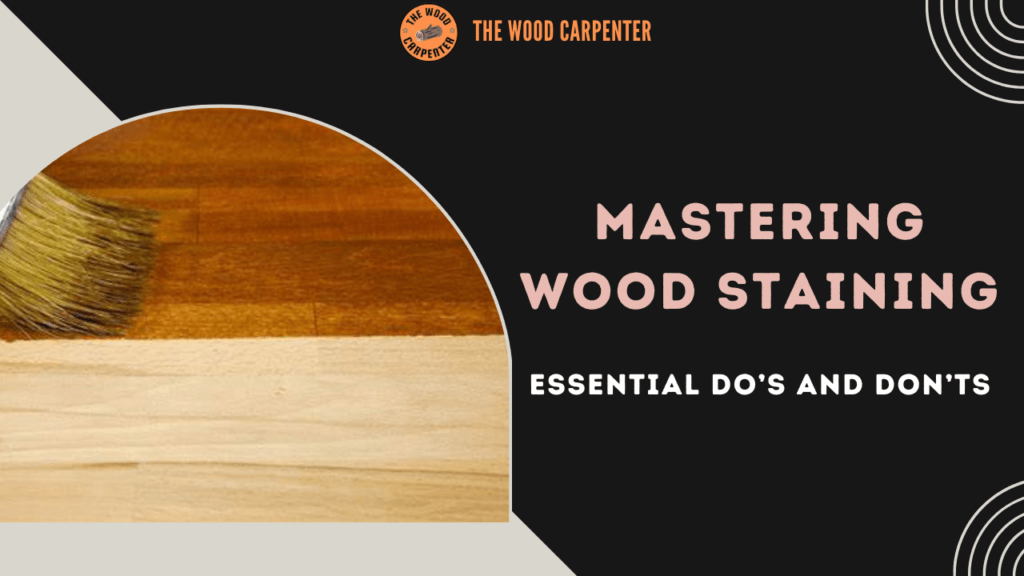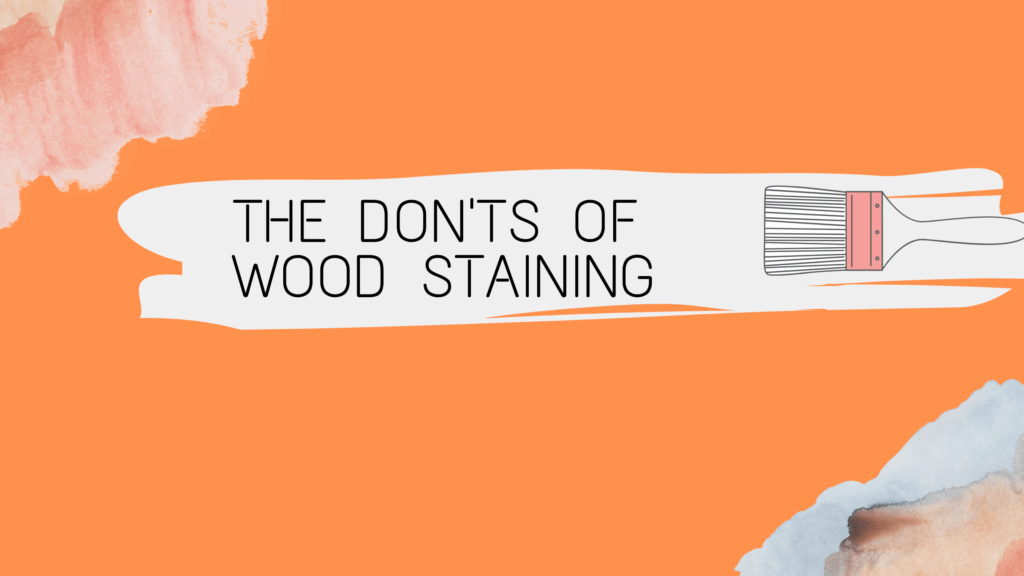
Wood staining is a great way to make it look better and protect it at the same time. Whether you’re working on a wooden table, chairs, or even a deck outside, the right wood stain can really improve how it looks and help it last longer.
But to get the best results, you need to use the right methods. Below, you’ll find some helpful tips and common mistakes to avoid when staining wood.
The Do’s of Wood Staining
1. Do Choose the Right Stain
Not all stains are created equal. When choosing a stain, consider the type of wood you’re working with and the finish you desire. There are two main types of stains: oil-based and water-based.
Oil-based stains tend to penetrate deeper into the wood, providing a rich, lustrous finish.
Water-based stains dry faster and are easier to clean up, but they may not offer the same depth of color.
Oil-Based Stain vs Water-Based Stain: Which One Should You Choose?
Make sure to choose a stain that’s suited for your project and the specific wood type, whether it’s oak, pine, or mahogany. Each species reacts differently to stain, so understanding how the wood will absorb the product is crucial.
2. Do Test Before Applying
Before you begin staining your entire project, it’s important to test the stain on a small, inconspicuous area or a scrap piece of the same wood. This will allow you to see how the stain reacts with the wood, ensuring that the color is what you expect.
Testing also gives you the opportunity to experiment with different application methods and to determine how many coats are needed to achieve the desired effect.
3. Do Prepare Your Surface Properly
Proper preparation is key to achieving a smooth, even finish. Start by sanding the wood surface to remove any old finish, dirt, or imperfections. A smooth surface allows the stain to absorb evenly, which is crucial for a professional look.
After sanding, thoroughly clean the wood using a tack cloth to remove dust. This step prevents particles from interfering with the stain and ensures a clean application.
4. Apply Stain Evenly
Use a brush, rag, or foam pad to apply stain, and always go in the direction of the wood grain. Don’t use too much stain at once, or it might look patchy. Work from one side to the other so you don’t leave lines or streaks.
5. Work in Small Sections
When staining a large surface, don’t try to do it all at once. Divide it into small sections so you can apply the stain more carefully and evenly, and avoid uneven drying.
6. Follow Drying Times
Let the stain dry completely before adding another coat. If you rush, the finish may look streaky. Always follow the drying times on the label, and remember it might take longer to dry if the air is humid.
Also read:
Shellac Finish: Do This for Perfect Wood finish !
Water Stains on Wood: 6 Step-by-Step Tricks to remove it
The Don’ts of Wood Staining

1. Don’t Skip Surface Prep
Skipping preparation is one of the biggest mistakes you can make when staining wood. Even if you think the surface looks clean, failing to sand or clean the wood thoroughly can lead to an uneven stain.
Sanding opens the wood pores, allowing the stain to absorb more evenly, while cleaning ensures that no dust or dirt will interfere with the application.
Wet Sanding Wood: A Complete Guide for Perfect Finishing
2. Don’t Apply Stain in Direct Sunlight
While it may seem like a good idea to stain your wood in bright sunlight, this can actually cause problems. Direct sunlight can make the stain dry too quickly, preventing it from penetrating deeply into the wood and resulting in an uneven or patchy finish. Try to stain your wood in a shaded area or on a cloudy day for the best results.
3. Don’t Overapply Stain
It’s easy to think that applying a lot of stain will give you a darker, richer color, but overapplying can have the opposite effect. Excess stain can leave a sticky, uneven finish and may never fully dry.
Always follow the manufacturer’s instructions for how many coats to apply, and be sure to wipe off any excess stain after application.
4. Don’t Forget to Protect Surrounding Areas
Staining can be a messy job, and it’s important to protect your furniture, floors, and other surfaces from splashes or drips. Use painter’s tape and plastic sheeting or old newspapers to mask off areas that you don’t want to stain.
This will make clean-up easier and ensure that only the wood gets the attention it deserves.
5. Don’t Rush the Process
Good things take time, and staining wood is no exception. Rushing through the process can result in mistakes, streaks, or uneven coverage. Take your time to prep, apply the stain carefully, and allow proper drying time between coats. If you rush, you might find yourself having to redo the job later.
Additional Wood Staining Tips
Choose the Right Stain: Oil-based stains offer rich color and durability, while water-based stains dry faster and are easier to clean up.
Use the Right Tools: High-quality brushes, foam applicators, or lint-free cloths can make application smoother.
Fix Mistakes Quickly: If you notice a mistake, wipe off the stain immediately with a clean cloth and mineral spirits (for oil-based stains) or water (for water-based stains).
Conclusion
Staining wood takes time and care, but it’s worth the effort. If you follow the right steps and avoid common mistakes, you can create a beautiful finish that lasts and shows off the natural look of the wood.
Always remember to test the stain first, prepare the surface well, and spread the stain evenly. And most importantly—take your time. Good results come from patience!
FAQs
How long should I wait before applying a second coat of stain?
You should wait at least 4-6 hours before applying a second coat, or as recommended by the stain manufacturer.
Can I use a brush or should I use a rag for staining wood?
Both tools can work, but using a clean rag or foam pad allows for a more even application.
What should I do if the stain is blotchy after application?
Sand the area lightly and apply a coat of conditioner to even out the staining.
Can I use a wood stain on pressure-treated lumber?
Yes, but make sure to let the wood dry thoroughly before staining to ensure better absorption.
Is it necessary to apply a wood finish after staining?
Yes, applying a finish can protect the wood from scratches, moisture, and UV damage.

